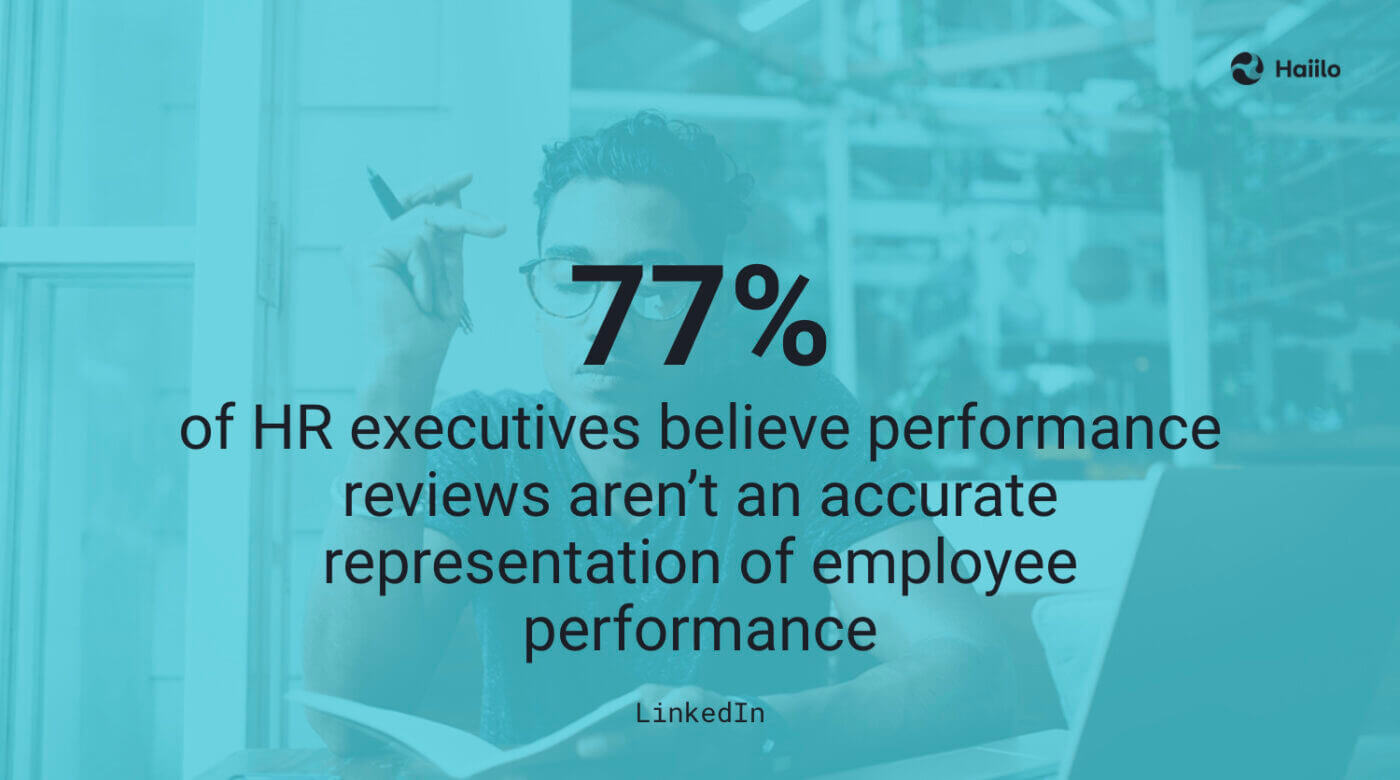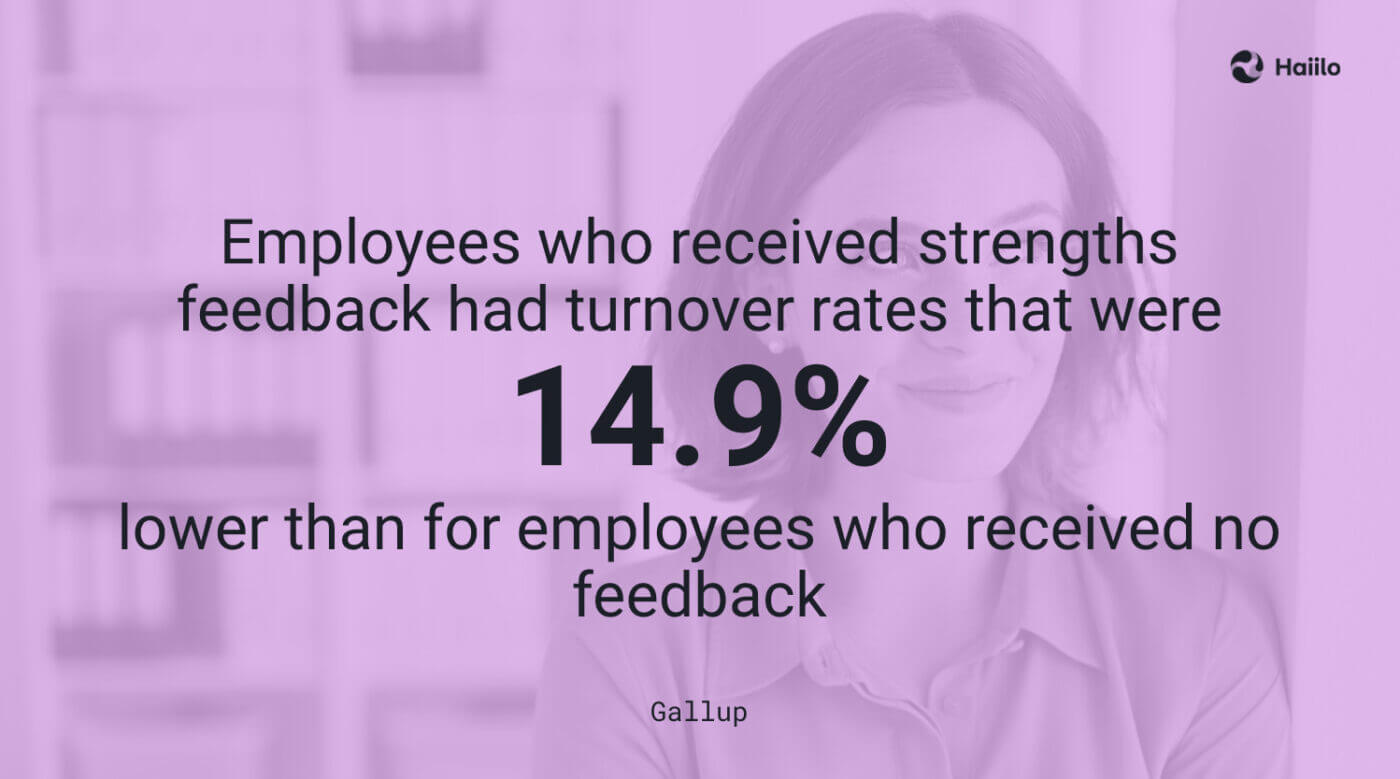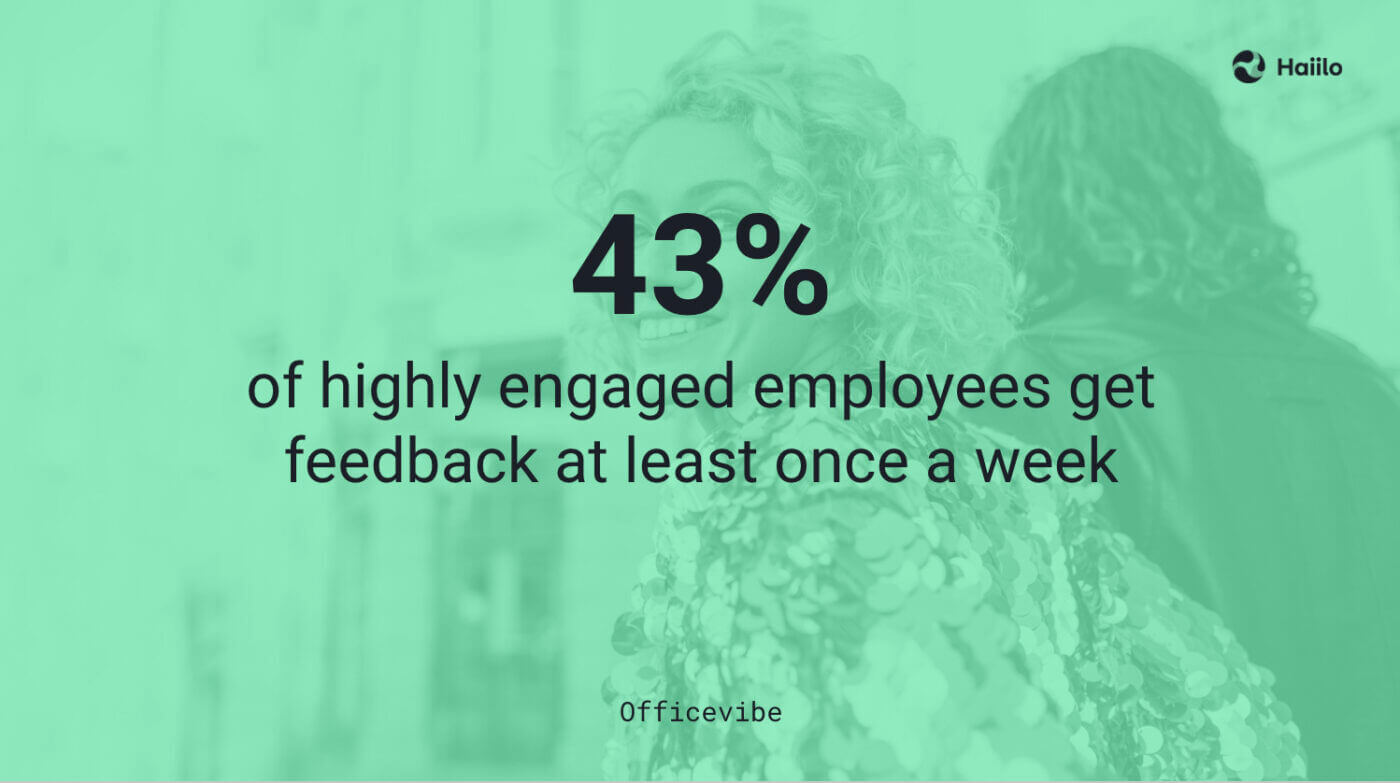Employee feedback is crucial for improving employee satisfaction, motivation, engagement, and productivity. Yet, many employees are still not happy with the way and frequency of receiving feedback from their superiors.
In this blog, we will cover the importance of employee feedback in the workplace and share some of the best practices for giving feedback to employees.
📙 Before we move forward, check out our guide Building a Better Company with Internal Communications.
The New Era of Employee Feedback
Historically, employee feedback was reserved for quartal, semi-annual, or annual performance reviews. With work becoming more and more agile, this approach is just not working anymore.
According to research, 77% of HR executives believe performance reviews aren’t an accurate representation of employee performance.

Today, employees expect continuous employee feedback from both their superiors and their peers.
Furthermore, remote work and distributed workplaces are also impacting the way employees collaborate and communicate with each other. Cross-functional collaboration is crucial now, and digital tools have become the only mean of communication for many organizations.
Employers need to adjust to these new trends, understand their people, and recognize the importance of on-the-spot feedback.
💡 Learn about 20 Ways to Engage and Connect with Your Remote Employees.
Why Employees Need Continuous Feedback
Employee feedback is one of the most important pillars of every talent management strategy. It greatly impacts employee experience in the workplace, and it can be one of the main causes of high employee turnover rates or low satisfaction and productivity rates.
Let’s take a look into the main reasons why employee feedback should never be neglected.
Employee motivation and engagement
Positive feedback and recognition have a direct impact on employee engagement and motivation in the workplace. According to research, 69% of employees say they would work harder if they felt their efforts were better recognized.
Every employer should, therefore, implement a structured employee recognition and feedback program. This is the best way to encourage and reward people for good work.
📹 Watch our Masterclass for improving employee engagement in the workplace.
Productivity and profitability
Besides boosting employee motivation and morale, employee feedback also improves productivity.
Great research by Gallup proved that managers who receive strengths feedback are more likely to have teams that show greater profitability:
- A study of 530 work units with productivity data found that teams with managers who received strength feedback showed 12.5% greater productivity post-intervention than teams with managers who received no feedback.
- In a study of 469 business units ranging from retail stores to large manufacturing facilities, Gallup found that units with managers who received strengths feedback showed 8.9% greater profitability post-intervention relative to units in which the manager received no feedback.
Employee retention
In general, employees who receive frequent feedback are more satisfied with their work. People who receive frequent feedback are always in the loop; they tend to be happier at work, which directly impacts their retention rates.
In the previously mentioned study, Gallup found that those who received strengths feedback had turnover rates that were 14.9% lower than for employees who received no feedback.

💡 Check out these 13 employee experience tips for building a better workplace!
9 Best Practices for Giving Employee Feedback
There are certain ways to make feedback more meaningful and useful for employees. Digital workplaces have to adjust to new ways of communicating with their peers and superiors. It is important to leverage the benefits and power of new workplace technology that makes it easier to connect with people.
So what are some of the best practices for giving feedback in the workplace?
1. Make feedback a part of your company culture
Driving a culture of frequent and honest workplace communications is not an easy task. However, it is absolutely necessary for a healthy work atmosphere and better business results.
Many organizations are now making frequent feedback a part of their core company values.
Honesty, open communications, and collaboration are some of the most common values employers try to embed in their employee behaviors!
2. Give feedback frequently
Today, most employees expect on-the-spot feedback from their managers and peers. Frequent feedback helps them stay on track and make sure that their work contributes to business success.
According to research, 43% of highly engaged employees get feedback at least once a week, compared to only 18% of employees with low engagement.

3. Understand your multigenerational workforce
Managing a multigenerational workforce is complex. Different generations expect different things from their employers.
According to PwC, nearly 60% of survey respondents reported that they would like feedback on a daily or weekly basis—a number that increased to 72% for employees under age 30.
Therefore, it is important to understand that younger generations, more than those older ones, expect more frequent feedback on their work.
4. Tie feedback to core values and business goals
To make employee feedback more meaningful, it is important to make it clear. This is why terms “value-based feedback” and “value-based recognition” were born. Feedback and recognition should always tie back to a company’s core values, mission, and ultimate business goals.
Employees want to be continuously reminded that their work has purpose and meaning, and they want to understand whether and how their contributions drive business results.
💡 Positive employee feedback can also improve employee morale. Learn about other ways to boost employee morale in the workplace!
5. Focus on the positives
Positive feedback reinforces and acknowledges a job well done, while negative feedback is corrective feedback that points out issues with behavior or performance and helps redirect misaligned priorities.
Whether the feedback is positive or negative, it should always be constructive, and it should mainly focus on the strengths. Otherwise, you risk leaving your employees feeling criticized, demotivated, and disengaged.
Employees are 30 times more likely to be engaged when managers prioritize feedback focused on their employees’ strengths.

6. Implement regular surveys and check-ins
Sometimes, it can be hard for managers to give regular feedback, especially for the ones who have remote and distributed employees. For them, it may be hard to continuously engage with their teams. This is why employee survey solutions have become so popular since the emergence of the pandemic.
Short surveys and employee check-ins are a great way to collect feedback and identify challenges employees may be facing. Based on these results, managers can dig deeper into the causes behind the challenges.
💡 Further reading: Top 15 Employee Motivation Tips and Benefits.
7. Don’t forget about your frontline employees
Giving and receiving feedback from frontline and deskless employees is usually much harder than employees with designated working spaces. Their nature of work usually requires employers to come up with different strategies to accommodate their blue-collar workforce.
Because frontline workers often depend on their smartphones to connect with managers and other colleagues, it is crucial that employers understand the benefits of investing in mobile-first internal communications technology.
8. Always act on feedback
Not acting on employee feedback can hurt your employees’ well-being.
Asking for feedback and not acting on it is worse than not asking for feedback at all. Unfortunately, many employers and managers still tend to ask for feedback just for the sake of it. This approach has a contra effect on employees, resulting in broken trust among people in the organization.
When you collect feedback from employees, make sure that you act on it in a timely manner.
9. Encourage bottom-up feedback
Bottom-up feedback is sometimes more important than top-down feedback. However, top-down feedback is still much more popular than bottom-up feedback. This is the consequence of low trust. Employees who don’t have trust in their managers are much less likely to speak up and give feedback to their bosses.
Organizations need to do a mindset switch and educate their managers about the importance of encouraging and driving bottom-up feedback. Even though not many managers feel comfortable receiving negative feedback from their employees, this is the only way for managers to become better leaders. This is the only way for managers to better support their employees throughout their career journeys.
10 Most Shocking Facts About Employee Feedback
Earlier in this blog, we covered the importance of regular employee feedback. But let’s now take a look at the 10 most shocking statistics that prove the power of feedback at work.
- 85% of employees take more initiative when they receive feedback in the workplace.
- 92% of employees agree that negative redirecting feedback, when delivered appropriately, is effective at improving performance.
- 80% of employees want feedback at the moment rather than delivering aggregated feedback for an annual or bi-annual review.
- 39% of employees report that they don’t feel appreciated at work.
- 80% of Gen Y said that they would prefer on the spot recognition over formal reviews.
- One in five employees are not confident that their manager will provide regular, constructive feedback.
- Employees are 2X as likely to be actively disengaged if employees are ignored by their manager.
- 4 out of 10 workers are actively disengaged when they get little or no feedback.
- 68% of employees who receive accurate and consistent feedback feel fulfilled in their jobs.
- 94.7% of highly engaged employees also feel their employer takes their feedback seriously.
Hybrid Work and Employee Feedback
As mentioned earlier, giving and receiving continuous top-down and bottom-up feedback is much harder now when workplaces are distributed and when hybrid work is growing in its popularity.
Many employers today rely on new workplace technology to mitigate the negative consequences of the new working models. Luckily, there are solutions that help peers and managers stay connected with each other and communicate efficiently, even in virtual working environments.
Haiilo is an employee engagement and employee communications platform that enables everyone to easily reach their colleagues and give or receive feedback. Its mobile-first interface empowers even frontline workers to stay connected with the rest of the workforce.
Robust workplace segmentation and survey distribution features empower managers and HR professionals to quickly collect feedback from the entire workplace, analyze results, and make smart decisions for improvement.
Personalized news feeds ensure that every employee is always in the loop about what is going on in the organization, and AI-powered analytics enable employers to better understand their employees’ communications preferences.










